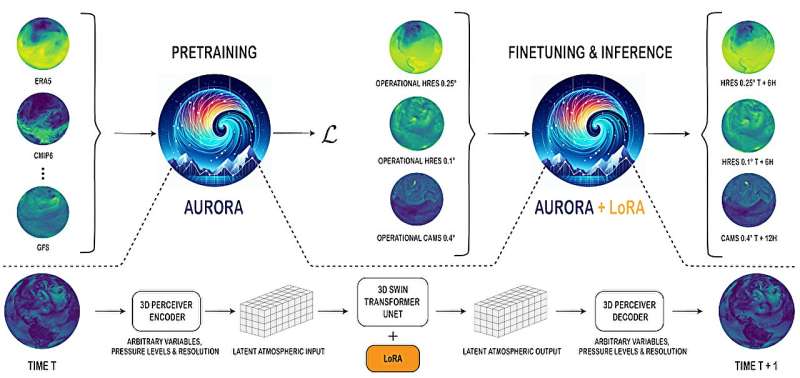June 5, 2024 report
This article has been reviewed according to Science X's editorial process and policies. Editors have highlighted the following attributes while ensuring the content's credibility:
fact-checked
preprint
trusted source
proofread
Microsoft unveils Aurora, an AI-based weather forecasting system that can also predict air pollution levels

A team of computer scientists at Microsoft Research AI for Science, working with a colleague from JKU Linz, another from Poly Corporation, and another from the University of Amsterdam, has built what Microsoft describes in its press release, as a "cutting-edge foundation model"—a system called Aurora that can be used to make global weather and air pollution level predictions more quickly than traditional systems.
The group has posted a paper describing their new AI system and how well it has tested compared to conventional weather prediction models on the arXiv preprint server.
Conventional computer-based weather prediction systems typically run on supercomputers because they rely on mathematical formulas that crunch massive amounts of data. More recently, several groups (such as DeepMind and Nvidia) have taken another approach: using AI-based applications that take far less time to run.
In this new effort, Microsoft, working with its research partners, has developed a weather prediction system that it claims rivals traditional systems but takes only minutes to run—and it can predict global air pollution levels as well.
Called Aurora, the system uses 1.3 billion parameters and was trained using millions of hours of data from six climate and weather models. It can make 10-day predictions for any part of the world. It can also be used to predict the size and severity of unique weather events, such as hurricanes.
Microsoft describes it as a system made with "flexible 3D Swin Transformers, with Perceiver-based encoders and decoders." The technology allows it to use a wide variety of atmospheric data, such as wind speed, air pressure, temperature and even greenhouse gas concentrations. And that, the researchers claim, allows the system to discover patterns that would not be seen otherwise—patterns that can lead to predictable outcomes.
Unique among its capabilities is Aurora's ability to predict air pollution levels for any given urban area around the world—and to be able to do it so quickly that it can serve as an early warning system for places that are about to experience levels of dangerous pollutants.
Such an ability, the team notes, could bring a new level of prediction to areas that up to now have been underserved, such as cities in third-world countries.
The research team concludes by noting that in side-by-side accuracy tests, Aurora's predictions were similar in accuracy to standard systems now run on supercomputers. Though they acknowledge that more testing will need to be done to determine the true accuracy of their system.
More information: Cristian Bodnar et al, Aurora: A Foundation Model of the Atmosphere, arXiv (2024). DOI: 10.48550/arxiv.2405.13063
www.microsoft.com/en-us/resear … l-of-the-atmosphere/
Journal information: arXiv
© 2024 Science X Network




















